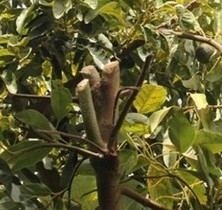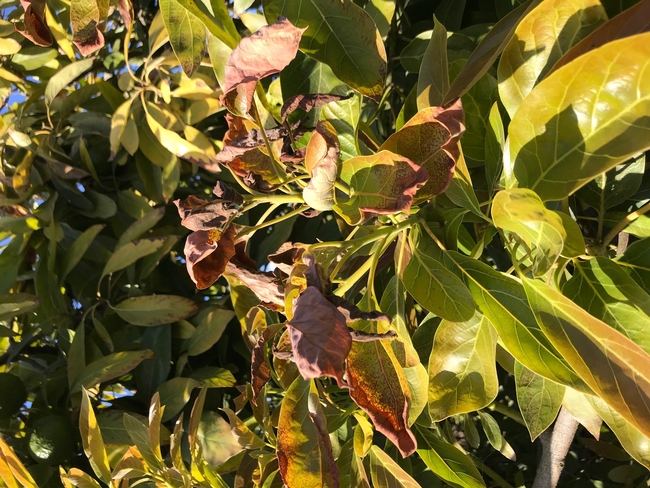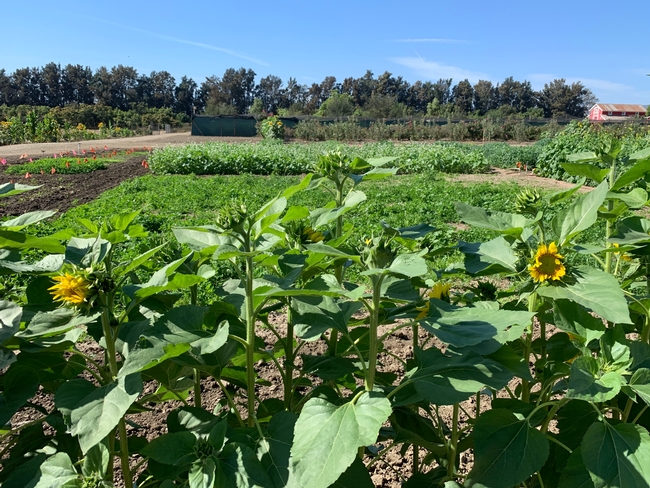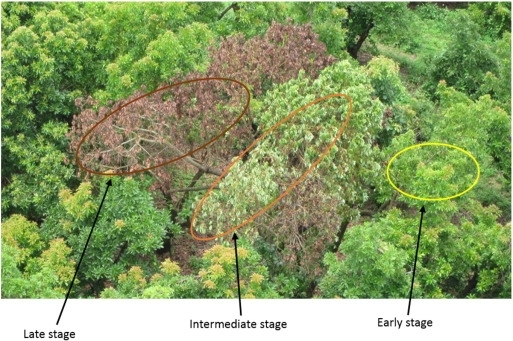When to Prune Avocados and Suggestions of How to Prune
In the past avocados were rarely pruned. In fact, if the trees got very big, growers would stump them down to 3-4 feet and then let them regrow. This would often be a disaster, since the trees rapidly grew to stupendous sizes again. They also might regrow then suddenly collapse, because all that regrowth was coming at the expense of energy being sent to the roots. If the roots were compromised by root rot, they would then not have the energy to fend off the disease. So, by bringing the canopy into balance with a sick root system that was continuing to die and was not being fed by a big canopy, the root death would accelerate and when the canopy and root system became imbalanced again, the whole canopy would collapse, and the tree would die.
Also, this wild regrowth was wild and hard to manage. The adage of “prune avocado trees cautiously” was heard round the avocado community and as a result many growers would not do anything. The trees growing larger and larger and larger with the fruiting canopy going higher and higher and higher and picking costs and liability going up. Tree thinning was practiced, where every other tree would be removed so that light could penetrate into the orchard, encouraging more fruit production and slowing tree growth. But they would still grow, and another thinning would be needed. The original commercial ‘Hass' orchard in Carpinteria started out in 1954 with 140 trees and 40 years later was down to 17 trees and was still productive, but they were monsters that were finally felled by root rot.
Many commercial avocados are now routinely pruned to keep the trees short, so that harvesting costs and other tree maintenance expenses are reduced. Also, more light shines into the trees, so that more fruit is borne on the lower branches. Light or minor pruning can be done any time of year to correct imbalances or limb breakages. However, major or heavy pruning should only be done in the early part of the year from January through April. Fall or early winter pruning can open up the canopy so that it is more prone to frost damage. The closed canopy holds in the heat better.
The major reason not to prune in fall and early winter is that a perennial, evergreen subtropical like avocado goes into a quiescent stage during the fall in preparation for winter cold. The tree does not go dormant like an apple or peach but goes into a metabolic state that can better handle cold. By pruning in the fall, the tree becomes actively metabolic and more prone to frost damage. The tree needs to slow down to better handle the cold.
Avocados flower and bear fruit at stem terminals, so if you give the tree and buzz cut (heading cuts), all the flower terminals will be cut off and there will be no flowering the following year. It also leads to an explosion of water sprouts that result from bud break up and down the branch because the terminal bud which controls the buds lower down have been removed. Naphthalene acetic acid (Tre-Hold) painted on the cut end can be used to restrict some of this wild bud break.
Whenever possible, thinning cuts should be made, where the branch is removed back to a subtending branch. This results in much less wild growth. Also, when there are buds that start growing into water sprouts, they can be nipped back to force lateral growth. These laterals will then slow down the growth of the sprout and the side terminal buds will also be able to grow and transition of flower buds later.
Work in Carol Lovatt's lab at UCR has shown that terminal buds need a certain maturity to flower and the transition from a vegetative bud to a flowering bud occurs sometime in late summer/early fall. If pruning is done in July, there is not enough time for the new buds to mature by August and there will be no flowers from that branch the following spring. New vegetative buds formed on growth from spring will often have enough maturation time to make the transition to flower buds, resulting in flowering the next spring.
Any major pruning done in later spring and summer is also going to require some protection for the remaining scaffolds from sunburn. Get ready to paint the scaffold with dilute latex paint to protect the once protected bark from sunburn damage. This can pretty rapidly kill the underlying cambium within days if it heats up newly exposed wood.
Again, light pruning can be done at any time of the year, but removing terminals is removing potential fruiting wood. Therefore, if heavy pruning is needed, it is best to remove one branch at a time. To reduce the height of a tree, cut out the tallest branch one year, the next tallest branch the following year, and so on until the tree is down to the height required. The process may take three to four years. By reducing the height over several years, the tree is put under less stress, less disease is likely to occur and fruit production is not drastically reduced. Pruning the sides of the tree should be done in the same way. Prune off a side branch that most impinges on a neighboring tree one year, then the next worst offender in the second year, and over the years continue this process until there is light all around the tree.
If pruning creates major open areas in the tree to sunlight where there once was shade, the exposed branches should be painted with white latex paint diluted with water so that it can be sprayed on. It needs to be white enough that it can reflect sunlight and avoid heat damage that can cause sunburn. Sunburn can utterly destroy all the work that has been done.
If the trees are really monsters, the only real alternative is to bring the whole tree down. But not stumping, rather scaffolding where much of the structure is maintained. This is where the tree is brought down to as high a height as is convenient and safe. By cutting the tree to a height of 8 feet or so, there is not so much rank regrowth because a greater portion of the tree is retained. Also, many times there are leafy branches that remain that will flower and fruit and slow the wild regrowth. Water sprouts that form should be headed back to force lateral growth that encourages stems that will flower, which will also slow the wild regrowth.
And one last warning. Do not. Do not. Do not. Got it? Prune sick trees. If the roots are compromised, the regrowth is going to be hard on the roots. Get the trees perked up with one of the phosphite products so that they are ready to go through this process. You may have to wait a couple years to start the pruning process until the trees are in shape for the rigors.
In summary: Late winter to early spring is the sweet spot for pruning your avocado trees. This timing is key because it sidesteps the risk of cold damage and aligns with the tree's natural flowering cycle. Pruning too late can lead to sunburned branches and a reduced fruit set the following year.
Image: Don't make cuts like this. Those stubs or going to create a royal mess of new, wild growth.

avocado pruning stub 1
Posted on
Friday, October 25, 2024 at
8:12 AM
Focus Area Tags: Agriculture

Happy Halloween! It is the time of year for Jack O' Lanterns, trick or treating, spooky decorations and funny costumes. This season is rich in diverse traditions including those of All Saints Day, Dia de los Muertos, and of course, Halloween.
But...
Posted on
Thursday, October 24, 2024 at
2:20 PM
Focus Area Tags: Agriculture, Environment, Family, Food, Health, Yard & Garden
Forecasts are for a mild La Nina which usually means low rainfall, cooler temperatures and relative humidities, all of which usually means greater conditions for freeze events. Watch some of these training videos from UC Davis Land Air Water Resources Department to prepare for those events:
https://lawr.ucdavis.edu/cooperative-extension/frost-protection
In the United States, the economic losses due to frost damage exceed all other weather-related phenomena. Although the economic, environmental, and social impacts of frost damage are significant on a local and global scale, the information available to the public, particularly growers, on how to avoid plant damage is insufficient. As a result, the University of California Cooperative Extension created the following narrated training units to provide growers with the scientific principles behind frosts and to demonstrate various methods to prepare for frosts and avoid plant damage. The training unit titled “Passive Frost Protection” discusses the basic definition and types of frosts, how frosts relate to atmospheric conditions, and the preventative measures that are carried out prior to a frost event to avoid or minimize damage. The training units “Active Frost Protection: Water” and “Active Frost Protection: Wind Machines” discuss the energy and labor intensive processes carried out during a frost event. The final training unit, “Methods of Measuring Temperature”, provides instructions for measuring various types of temperatures critical to frost monitoring and describes several of the frost alarm systems available to growers.ystems available to growers.
Additional features
- English and Spanish Versions
- Incorporate examples from certain types of crops with a primary focus on vineyards
Training Units :
The presentations below will run automatically on your computer, and include recorded audio.

frost damage leaves
Posted on
Wednesday, October 23, 2024 at
8:07 AM
Focus Area Tags: Agriculture
Come hear about cover crops and how we measure their effects on soil and improved growing conditions
Climate-Smart Farming Demonstration Field Meeting
November 6, 2024 9:00 AM - 11:45 AM
5352 Beardsley Rd.
Camrillo, CA 93010
Contact: Siomara Zendejas siozendejas@ucanr.edu
Sponsor: California Farm Demonstation Network
Details:
Climate-Smart Farming
Demonstration Meeting
Part 1 (9-10:30am): UC Hansen REC
5352 Beardsley Rd. Camarillo, CA
Part 2 (10:40-11:45am): Rodale Institute COC, McGrath Farm
1012 West Ventura Blvd, Camarillo, CA
Click here to view the flyer

cover crop trail Hansen
Posted on
Monday, October 21, 2024 at
7:32 AM
Focus Area Tags: Agriculture
Ambrosia Beetle Research Project Seeks California Avocado Groves to Survey
Dr. Paul Rugman-Jones is collaborating with University of Florida researchers on a project called, "Sustaining avocado production in the face of the lethal laurel wilt disease". As part of this project, he is looking to survey California avocado groves located in Ventura, San Diego and Riverside/San Bernardino Counties.
Currently, laurel wilt in Florida is spread — particularly in avocado — by several ambrosia beetle species. While California does not yet have laurel wilt or the red bay ambrosia beetle, through his research Dr. Rugman-Jones hopes to pre-emptively gather knowledge that will help the California avocado industry prepare in case that were to change.
Dr. Rugman-Jones seeks to sample at least two commercial California avocado orchards in each of the above-noted counties three times in 2025 and 2026 — in the spring, summer and fall. On the first visit each season, a series of Lindgren funnel traps will be placed in the orchards and baited with known ambrosia beetle attractants. The traps will be not allow the insects to escape. The contents of the traps will be collected after two weeks, refilled and then recollected after two weeks. During the visits, he will walk the groves looking for evidence of ambrosia beetle infested branches. With the permission of the grower, he would remove and bag those branches for study at a quarantine facility.
In addition to avocado, he will conduct limited surveys of California Bay Laurel and Camphor tree, both of which are susceptible to laurel wilt, and may provide a network of inoculative sources for secondary translocation of the laurel wilt pathogen into avocado orchards.
Growers who are interested in participating in the study should contact Dr. Rugman-Jones at paulrj@ucr.edu.

laurel wilt stages
Posted on
Friday, October 18, 2024 at
7:31 AM
Focus Area Tags: Agriculture







